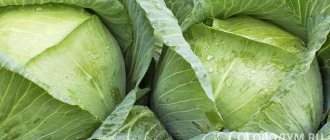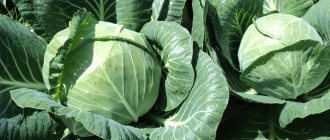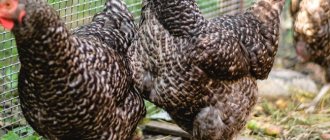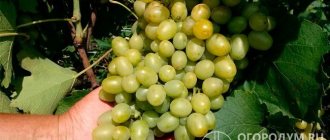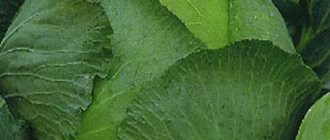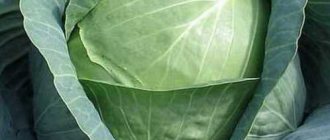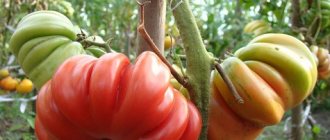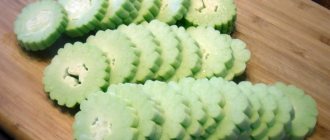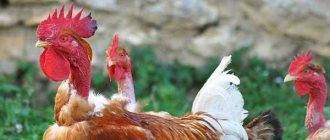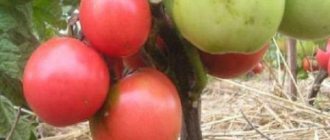Vegetable growing » Cabbage
0
1374
Article rating
Kira Stoletova
Cabbage Golden hectare 1432 is an early variety. It is ideal for both agricultural production and home cultivation.
Characteristics of cabbage variety Golden Hectare
Description of the cabbage variety Golden Hectare
The root system of the Golden Hectare cabbage is a taproot. The depth of its penetration into the soil is from 30 to 40 cm. Small roots go much deeper - up to 1 m.
The stem is a short and thick stalk. It is very leafy. The stem color is white-green.
The leaves are round, quite large underneath, gray-green with veins.
In the upper part, small leaves are collected in round forks. They are white.
The leaf rosette is slightly raised. It is small in size (circumference 60-75 cm). The leaves themselves are entire, located on short petioles. Their surface is smooth, in rare cases slightly wrinkled. The stalk inside the head of cabbage is small.
Ripening time ranges from 100 to 110 days. The harvest is harvested almost simultaneously, since ripeness occurs immediately in all specimens.
Temperature
In order for the seedlings to grow strong and form quickly, the temperature regime must be observed. Before the first shoots form, the room temperature should be +19 degrees. After they are formed, the temperature during the day should be +17 degrees, at night - +10 degrees.
14 days before transplanting into open areas, the sprouts need to be hardened off. At the first stage of hardening, the plants need to be gradually accustomed to cool air; several hours a day is suitable for this. At the next stage, the sprouts need to be taken outside.
It is necessary to ensure that direct rays of the sun do not penetrate the inflorescences; for this purpose, create a shadow. The seedlings remain outside for the last couple of days. After 5 leaves appear, the seedlings are dug into an open area.
Pros and cons of Golden Hectare cabbage
The positive features of the Golden Hectare cabbage variety include:
- early and simultaneous maturation;
- high productivity;
- excellent taste;
- unpretentiousness in cultivation;
- excellent disease resistance;
- high resistance to pests.
Negative aspects of culture:
- impossibility of long-term storage;
- poor transportability.
It should be noted that among the early varieties, Golden Hectare cabbage has a fairly long shelf life - about 1 month. In other species, this figure is no more than 1 week.
Preparing the site for breeding
The Golden Hectare variety is an unpretentious type of cabbage. It does not require special soil preparation or site selection. To obtain maximum yield, gardeners choose a well-lit area for cabbage. Lack of light leads to the formation of small leaves and poor formation of heads of cabbage.
Loamy or light loamy soil is considered optimal for the variety. Cabbage reacts negatively to increased soil acidity.
To increase productivity, it is recommended to carry out preliminary preparation of beds for cabbage. Preparation consists of adding lime solutions to the soil in the autumn to reduce acidity, as well as adding fertilizers to increase soil fertility. The best predecessors for the Golden Hectare are:
- nightshades (pepper, tomato, potato);
- legumes;
- pumpkin;
- onion.
Fertilizing the soil before planting
Planting and caring for Golden Hectare cabbage
Golden Hectare cabbage grows best in sunny areas with loamy soils. Depending on the climate, the crop can be grown in open ground or through seedlings. Plants are planted at a distance of 0.5-0.7 m from each other.
Important! To obtain very early harvests, the seedling method of cultivation is used.
Seeds are planted in open ground at the end of April. When growing seedlings, this is done at the end of March, and young plants are transferred to the beds in mid-May. In this case, you can take soil similar to what is in the garden. Watering the seedlings is done once every 2-3 days, as the soil dries out; there is no need to fertilize before planting in open ground.
Caring for adult plants is quite simple: watering twice a week with 5-10 liters, regularly loosening the beds and killing weeds
Fertilizing is done 3 times a season: in the middle and end of May and in the second ten days of June. In all cases, a mixture of nitrogen and phosphorus-potassium fertilizers is used.
Important! 1-2 weeks before harvesting, stop watering and fertilizing.
Seedling growing method
In order to get cabbage as early as possible, it is best to use the seedling growing method. In this way, you will protect the plant at a young age from pests and diseases and ensure the formation of full-fledged heads of cabbage with a long growing season.
Preparing seeds for sowing
Seeds sold, as a rule, are already sorted and disinfected and do not require additional processing. If you bought seeds of questionable quality, or use your own material, then it is necessary to carry out pre-sowing preparation.
Against clubroot and other fungal diseases, the seeds are placed for 20 minutes in warm water heated to 50 degrees. The water temperature is maintained at the same level. Then the seeds are placed in cool water for 3-5 minutes and dried thoroughly.
During the disinfection process, floating and small seeds are removed.
There are two ways to grow seedlings: potted and potless. In both cases, sowing seeds can be done with or without further picking.
Pot method
Recently, potted seedlings have been increasingly used. Its advantage is good survival rate, because the root system is kept intact before planting.
If you want to grow early cabbage seedlings without picking, then sowing should be done from late February to mid-March. Preparing the soil for seedlings includes mixing soil and humus in equal parts and adding mineral fertilizers: 30 g of superphosphate, 15 g of potassium nitrate, 10 g of ammonium nitrate per bucket of the mixture. Or any complex fertilizer for cabbage.
As a soil for seedlings, you can use transitional or lowland peat with the addition of sand and sawdust. In the absence of microfertilizers, ash is added to the soil mixture at the rate of 2 cups per bucket.
When the soil for seedlings is prepared, you can start sowing:
- Sow 2-3 cabbage seeds into each container at a depth of 1.5-2 cm in order to select the most successful seedling in the future. After sowing, water the soil generously with water at room temperature. For faster germination of seeds, the pots can be covered with film.
- Maintain the seeded material at a temperature of 25 degrees until seedlings emerge. Then lower the temperature to 8-10 degrees to avoid stretching the seedlings. With the appearance of the first true leaf, raise the temperature to 15-17 degrees during the day and to 10 degrees at night.
- Lowering the temperature at night is necessary so that the seedlings do not grow pampered. Such seedlings do not take root well in the soil. Good seedlings ready for planting in the ground should be stocky and have 4-5 true leaves.
- Keep the soil moderately moist during the growing process to prevent the plant from becoming infected with blackleg. If you discover this disease, ventilate the room and sprinkle the soil with the plant with dry sand. To protect against diseases, add potassium permanganate (3 g per 10 liters of water) to irrigation water.
Potless method
When growing in large volumes or when there is not enough space, use a potless method of growing seedlings. To do this, place the prepared wet mixture in an even layer of 5-6 cm in the boxes and make grooves at a distance of 3-4 cm from one another.
In the phase of 1-2 true leaves, pick the seedlings into pots measuring 6 by 6 cm, or thin out the plants at a distance of 5-6 cm without picking. In potless seedlings, only 10% of the volume of the root system is retained during transplantation.
Potless method with preservation of the root system
There is another way to grow seedlings, which does not involve the use of containers, but it keeps the root system as intact as possible. With this method, pots are formed from well-moistened soil mixture.
To prevent the soil from crumbling when watering, mullein is added to it as a binding material. Its consumption should be no more than 0.5 liters per 1 bucket of mixture. Be careful when preparing this composition, because an excess of mullein will make the soil too dense, which will adversely affect the development of seedlings.
Place the wet mixture in an even layer of 5-6 cm in boxes or directly on the covered soil in a greenhouse, compact it slightly, and then cut along the entire height along and across, forming cubes 6 by 6 cm.
Cabbage yield Golden hectare
The yield of Golden Hectare cabbage ranges from 5 to 8 kg per square meter. Accordingly, you can remove up to 800 kg from one hundred square meters. But these are indicators typical for industrial cultivation. In a private garden or cottage, the yield decreases by 2-5 times. According to reviews from those who grew the Golden Hectare variety, several tons are harvested from ten acres.
Increased yields can be achieved by planting crops more densely and following agricultural practices. Increasing the volume of fertilizers and watering rates during cultivation are not justified, since the plant will not have time to process them, and a large amount of nitrates and sulfates will accumulate in its tissues. It will become impossible to eat such cabbage.
Characteristics of the variety
| Variety or hybrid | Variety |
| Productivity | Up to 9 kg/m2 (900 c/ha). |
| Resistance to diseases/pests | A highly disease-resistant variety, if not properly cared for it can be susceptible to cabbage clubroot and white rot. |
| Preferred soil |
|
| Frost resistance | High. |
| Growing areas | Tolerance regions include:
|
| Ripening period | Medium early. |
| Mass of heads of cabbage | 1.5-2.5 kg. |
| Planting scheme | 60x60 cm. |
Diseases and pests
The Golden Hectare cabbage variety has good resistance to diseases and pests. This is not surprising, since this is precisely what the culture was bred for. Breeders have made every effort to select a stable and unpretentious variety.
But, despite this, with a serious deviation from agrotechnical standards, Golden Hectare cabbage can be attacked by various fungal infections. First of all, this applies to plants that are watered too much.
Important! Diseases characteristic of storage (gray and white rot, Alternaria and others) are not dangerous for Golden Hectare cabbage, since it does not sit for a long time.
One of the common diseases is powdery mildew. Its symptoms are known to any gardener. With it, various parts of the plant are coated with a powdery coating several millimeters thick.
A feature of powdery mildew on cabbage are black spots - a manifestation of tissue necrosis
The cause of the appearance of the fungus that causes the disease is the plant remains of the previous year, which contain its spores. The active phase of treatment of the disease involves the use of the drugs Phytophtorin and Ridomil. If you do not want to use such powerful means, you can get by with something simpler: spraying with a 1% solution of Bordeaux mixture.
But it is best to carry out preventive measures in the form of treating the soil with copper-containing preparations some time before planting the crop in open ground. This may be the already mentioned Bordeaux mixture or a solution of copper sulfate.
Of the pests characteristic of cruciferous vegetables, Golden Hectare cabbage can be affected by white cabbage during mass summers. This is the main enemy of the crop, periodically appearing even on the most resistant varieties.
The main problem is not the adult whites, but their larvae, which have a characteristic color
Over the summer, 2 to 3 generations of butterflies can change. In fact, it takes the fourth to winter. Since the Golden Hectare cabbage variety is early, it falls under the first two generations of the pest. Moreover, one will parasitize on young plants, and the second on those already ready for harvest.
No other pest, not even cruciferous flea beetles, has such a detrimental effect on cabbage, so flea beetles should be dealt with especially carefully, regularly inspecting the plants for caterpillars and eggs.
Fortunately, the whitefish does not have good resistance to poisons, and drugs that are not particularly dangerous to humans can be used to neutralize it. These include Karbofos, Iskra M and others.
How much money do you need to start a business?
If you decide to open an enterprise specializing in growing cabbage, you need:
- pay for business registration;
- buy inventory and equipment (the issue of expensive equipment can be resolved with the help of leasing companies);
- rent a warehouse, administrative premises and garages;
- purchase the most necessary office equipment (PC, printer, telephones, etc.);
- buy fertilizers and planting material.
The list of costs does not end there. You definitely need to carry out promotional events, buy a plant watering system, build a greenhouse (at least for growing seedlings), and also pay for renting a plot of land. As a result, even to organize the activities of a small farm you need to invest from 5-15 thousand dollars, and if you plan to engage in a larger-scale business, you will need investments 10-20 times more.
Application
Since Golden Hectare cabbage is an early ripening variety, its shelf life is short, no more than a month. Therefore, the harvested crop needs to be consumed or processed as soon as possible.
It is used raw in various salads; first and second courses, as well as pies, are made from the Golden Hectare. For consumption at a later date, preserved food is used. Salted and sauerkraut Golden Hectare is able to retain its good taste and most of its vitamin content for 3-4 months. When preserved with sterilization, these periods can be extended to 5-7 months.
Agricultural techniques for growing in open ground
In central Russia, the Urals, Siberia and the Far East, early cabbage, including June cabbage, is usually planted in open ground in early May.
It will be much worse if the cabbage is planted 7–10 days late. Then the time for pouring the head of cabbage will fall in hot July. If a fork gets tied, it will certainly be loose or cracked.
Autumn preparation of beds
The bed for cabbage has been prepared since autumn. The soil is dug up, saturated with rotted manure or peat compost, and fertilized with wood ash.
Cabbage beds should be set up in the fall, generously filling them with peat compost.
In addition, the area should be well lit and drained. Drainage outlets can serve as deep furrows along the perimeter of the beds, ordered by area from 20 to 40 m2.
Planting seedlings in open ground
Before planting seedlings in open ground, they must reach 40–45 days of age and acquire 4–5 true leaves. The best time to manipulate seedlings is in the evening after 17-00 on the eve of spring rain.
Cabbage seedlings that have 4–5 true leaves are considered ready for transplanting into open ground
Procedure:
- The holes are dug in the spring and fertilized (despite the fact that in the fall the entire bed was enriched with nutrients). Peat compost or humus is suitable (250–300 g per hole at least 15 cm deep). The fertilizer is mixed with garden soil.
- Before removing plants from their seedling containers, water them thoroughly and allow time for the water to soak into the soil. This technique will make it easier for the roots to emerge from the ground and will not cause serious injury to them.
Before removing plants from seedling containers, water them thoroughly
- The seedlings are removed from the pots and dipped into a solution with a growth stimulator for 1–2 minutes.
Plant roots can be immersed in a solution with a growth stimulator for 1–2 minutes.
- The cabbage root is placed in the center of the hole, covered with soil, watered abundantly and covered again with dry soil so that the moist layer under it is preserved for as long as possible.
The cabbage root is placed in the center of the hole and covered with soil.
Peat pots are installed completely in the hole, the seedling is not removed
Feeding cabbage in open ground
7–10 days after transferring the seedlings to open ground, it is necessary to carry out the first fertilizing. It is necessary in order to:
- give the plant additional immunity from diseases and attacks from garden pests;
- prevent the formation of arrows and the departure of cabbage into the flowering phase;
- promote ovary fork and increase strength in leaves.
Feeding will not only give the plant additional immunity, but will also prevent the formation of shoots
As a nutrient mixture, you can take a solution with the addition of 20 g of ammonium nitrate and 20 g of superphosphate per 10 liters of water. This amount will be enough for 1 m2 of area or four cabbage plants. In addition, there is a number of effective fertilizers that stimulate the formation of the ovary, where all elements are balanced and ordered. These include:
- WMD,
- Agricola,
- Sotka,
- Planta,
- Ovary for cabbage.
After another 7 days, a second feeding is carried out. A solution of mullein in a ratio of 1:10 or a mixture of ready-made fertilizers is suitable. It is advisable to use a different brand of fertilizer to vary the nutritional value.
Applying fertilizers to dry soil is unacceptable - plants should be watered thoroughly before fertilizing
It should be remembered that fertilizing cannot be carried out on dry soil, so a sufficient and abundant spill of clean water before the procedure is mandatory. With insufficient moisture, cabbage leaves suffer, curling and becoming covered with a bluish coating. The best time for fertilizing is considered to be a cloudy morning after an overnight rain.
Reviews from gardeners
Vladimir Ivanovich, Rostov, 49 years old.
We grow several varieties of cabbage. Among the early ones is the Golden Hectare. We have Golden Acre seeds. Early cabbage, medium-sized head, around 2.5 kilograms, rarely more. The taste is excellent, I would even say very good. In terms of care, it is demanding, like any early variety. Loves fertilizing, compost, mineral water, etc. We have been growing seeds all the time, and last year we purchased seedlings. We regretted this very much. They took it from an unverified person at the market. He told me everything was good, etc., the seedlings are strong and fifth to tenth. As a result, they brought the clubroot to their site. But this is an infection that is very difficult to remove from the garden. Now I'm afraid for the new harvest.
Larisa Alexandrovna, Kyiv, 53 years old.
Overall I liked the variety. The cabbage is early ripe and does not crack. We buy seeds from a trusted place, they germinate well, almost 100%. Despite the fact that many people talk about poor preservation, my Golden Hectare is preserved quite well. Among the shortcomings, I can note the following: the leaves taste a little harsh. Cabbage is slightly sour. And the last drawback is that this is a rather capricious variety that requires good feeding and watering, and this despite the fact that the heads of cabbage generally grow no more than 1.5 kg.
Ekaterina Viktorovna, Minsk, 34 years old.
I like the Golden Hectare. Early cabbage is very different in taste from middle and late cabbage - much sweeter. I use it raw, make fresh salads with mayonnaise or sunflower oil, and prepare cabbage pies from it, adding it to borscht. They say it can be fermented, but I have never fermented early varieties. Seeds germinate 100%. After diving, the sprouts take root very quickly on the site. There is no need to perform any dances with tambourines near the vegetable. I water, fertilize periodically, and hill up once a season. Heads of cabbage of medium density. One of the disadvantages can be noted that cabbage very quickly outgrows and cracks. But if you collect it on time, there will be no problems.
